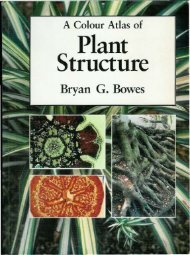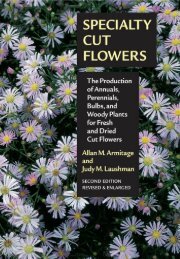You also want an ePaper? Increase the reach of your titles
YUMPU automatically turns print PDFs into web optimized ePapers that Google loves.
aniline stainsbacteria and lactic acid bacteria. Compareaerobe.anaerobic respiration Respiration inwhich oxygen is not involved, found in almostall organisms. <strong>The</strong> organic substrateis not completely oxidized and the energyyield is low. <strong>The</strong> glycolytic pathway,whereby glucose is degraded to pyruvate,with the production <strong>of</strong> a small amount <strong>of</strong>energy, is the same as in aerobic respiration,but after that, in plants and fungi,ethanol and carbon dioxide are producedas the end products <strong>of</strong> the process, normallyknown as FERMENTATION. In animalslactic acid is produced and normally remetabolizedwith oxygen at a later stage. <strong>On</strong>lytwo molecules <strong>of</strong> ATP are produced by thisprocess. See anaerobe; glycolysis. Compareaerobic respiration.analogous Describing structures thatare apparently similar (structurally orfunctionally) but have a different evolutionaryorigin, and thus a different embryologicalorigin and structure. Phyllodes areanalogous to leaf blades, but are derivedfrom petioles (leaf stalks). See also homologous.anaphase <strong>The</strong> stage in mitosis or meiosiswhen chromatids are pulled toward oppositepoles <strong>of</strong> the nuclear spindle. Inmitosis each <strong>of</strong> the chromatids moving towardthe poles represents a single completechromosome. During anaphase I <strong>of</strong> meiosispairs <strong>of</strong> chromatids still connected at theircentromere move to the spindle poles. Duringanaphase II the centromeres divide andsingle chromatids are drawn toward thepoles, thus sister chromatids are separated.anatomy <strong>The</strong> organization <strong>of</strong> the parts<strong>of</strong> the body and the structural relationshipsbetween them, including the arrangement<strong>of</strong> tissues and their component cells.anatropousSee ovule.androdioecious Describing species inwhich there are two forms, one bearingonly male flowers, the other bearing onlyhermaphrodite flowers (or occasionallybearing male and female flowers, i.e. MO-NOECIOUS). Compare gynodioecious.androecium <strong>The</strong> collective name inhigher plants for the male parts <strong>of</strong> a plant,i.e. the STAMENS. It is denoted in the floralformula by a letter A.andromonoecious Describing speciesin which both male and hermaphroditeflowers are borne on the same plant. Comparegynomonoecious.anemophily Pollination by wind. Plantspollinated in this manner (e.g. grasses) usuallyhave insignificant unscented flowerswith large, <strong>of</strong>ten feathery stigmas.aneuploidy <strong>The</strong> condition, resultingfrom nondisjunction <strong>of</strong> homologous chromosomesat meiosis, in which one or morechromosomes are missing from or added tothe normal somatic chromosome number.If both <strong>of</strong> a pair <strong>of</strong> homologous chromosomesare missing, nullisomy results. Monosomyand trisomy are the conditions inwhich one or three homologs occur respectively,instead <strong>of</strong> the normal two. Polysomy,which includes trisomy, is thecondition in which one or more chromosomesare represented more than twice inthe cell. See nondisjunction.aneuspory <strong>The</strong> production <strong>of</strong> an unusualnumber <strong>of</strong> spores during meiosis <strong>of</strong> aspore mother cell. In dandelion (Taraxacum),for example, the chromosomes <strong>of</strong>the megaspore mother cell remain in onecell after the first meiotic division, forminga restitution nucleus. <strong>The</strong> second meioticdivision thus gives rise to two cells with thediploid number <strong>of</strong> chromosomes, one <strong>of</strong>which divides parthogenetically to form anembryo. This is a form <strong>of</strong> APOMIXIS. Sincecrossing over can occur during the firstmeiotic division, it does allow for some geneticvariation in the <strong>of</strong>fspring. See parthenogenesis.angiosperms <strong>The</strong> flowering plants constitutingby far the largest phylum (Antho-15





